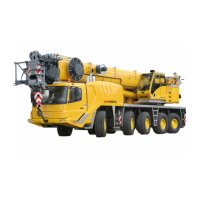3-105
RT9150E OPERATOR MANUAL OPERATING CONTROLS AND PROCEDURES
Published 2-23-2017, Control # 644-00
OPERATING PROCEDURES
New Crane Conditioning
Your new Grove carrier has been thoroughly tested,
adjusted, lubricated, and inspected prior to delivery. For
detailed engine conditioning, refer to the applicable engine
manual.
The guidelines below will aid in getting a long service life out
of the crane.
1. Operate as much as possible in the half to three-
quarters throttle or load range.
2. Avoid long periods of operation with the engine at idle or
continuous maximum horsepower levels.
3. Observe instruments often and shut down at the first
indication of an abnormal reading.
4. Operate to a power requirement that allows acceleration
to governed speed when conditions require more power.
5. Check all components frequently for proper operation,
unusual noises, and excessive heating.
6. Check the engine oil and coolant levels frequently.
These guidelines should not be considered limitations but
rather as a guide for familiarization of the machine and
development of good operating habits.
Pre-Starting Checks
A complete walk-around visual inspection of the crane
should always be made with special attention to structural
damage, loose equipment, leaks, or other conditions that
would require immediate correction for safety of operation.
The following checklist items are suggested specifically for
the operator’s benefit to make certain his crane is prepared
for starting the day’s work.
Fuel Supply
Check the fuel level and make sure the cap is on tight.
Engine Oil
Check the oil level in the crankcase and fill to the FULL mark
on the dipstick. Do not overfill.
Engine Coolant
Check the coolant level in the radiator and fill to the proper
level. Do not overfill and check to make sure the cap is
secure.
Batteries
Check that the battery cables and clamps are tight and not
corroded.
Signal and Running Lights
Check all signal and running lights for proper operation.
Replace burned out lamps with those of the same number or
equivalent.
Foot and Parking Brakes
Check the foot and parking brakes for proper operation.
Daily Lubrication
Make certain that all components requiring daily lubrication
have been serviced. (Refer to Section 5, Lubrication.)
Hydraulic Reservoir and Filter
Check hydraulic fluid quantity level and filter condition
indicator. Check breather for cleanliness and ensure it is
secure.
Tires
Check for severe cuts, foreign objects embedded in treads,
and for correct inflation pressures. A tire inflation chart,
providing the correct air pressures, is located in the Load
Chart Book in the crane cab.
Wire Rope
Inspect wire rope in accordance with applicable Federal
Regulations.
Inspect sheaves, guards, guides, drums, flanges, and any
other surfaces that may come in contact with the rope for any
condition that could cause possible damage to the rope.
Hook Block
Visually inspect for nicks, gouges, cracks, and evidence of
any other damage. Replace any hook that contains cracks or
shows evidence of excessive deformation of the hook
opening, including twist. Be sure the safety latch is free and
aligned.
Boom
Ensure the large access cover on top of the boom base
section is in place. The boom should not be operated unless
it is installed.
Air Cleaner
Check the filter condition indicator. Check filter and tubing for
security.
Access Hole Covers (CE Units)
Ensure the covers are installed in all access holes in the
boom and the outrigger beams.
Wind Forces
Wind can have a significant affect on loads that may be lifted
by a crane. Wind forces act differently on a crane depending
Reference Only

